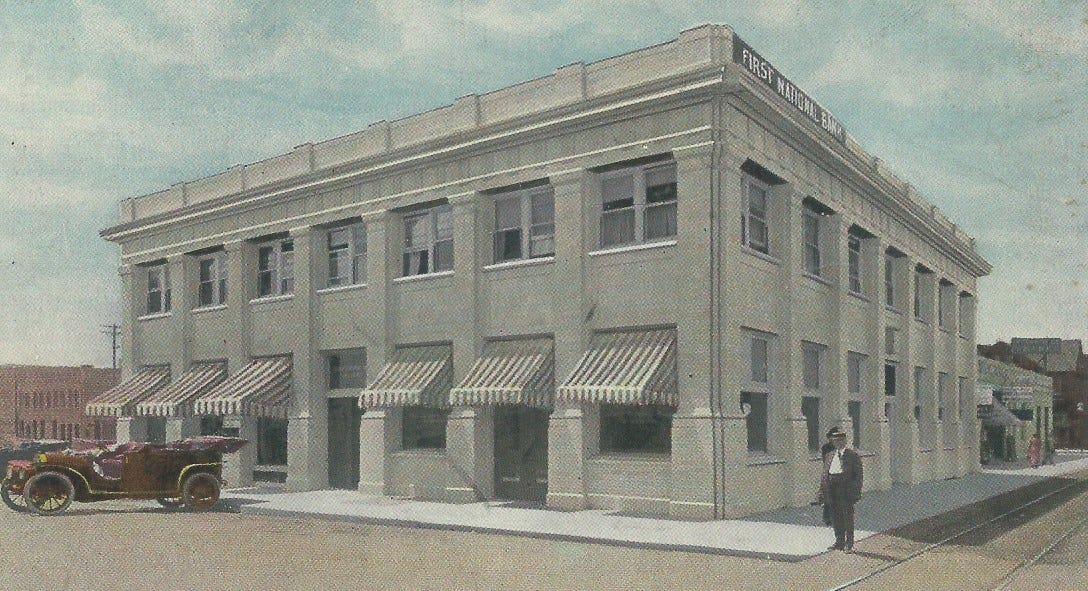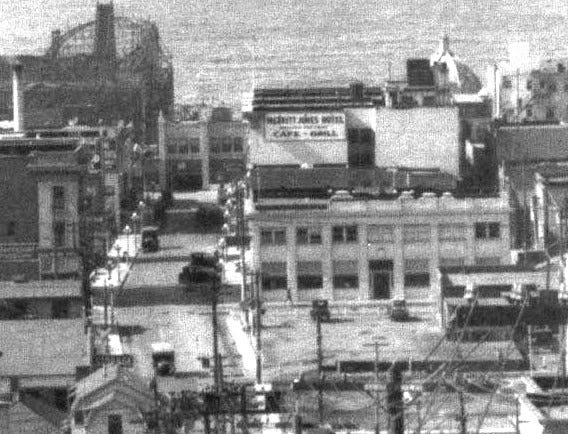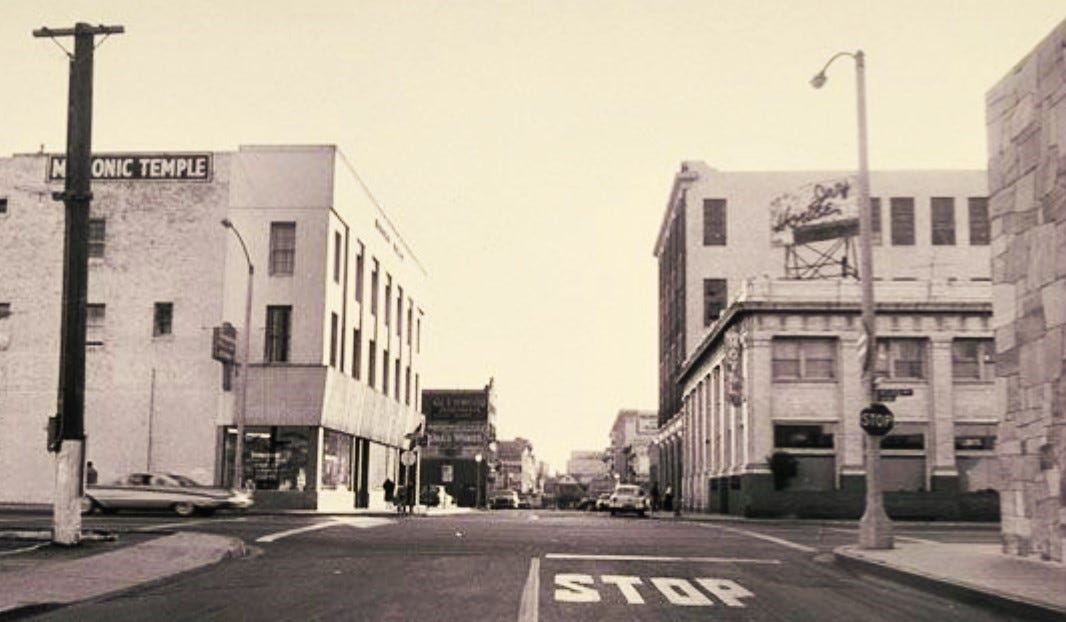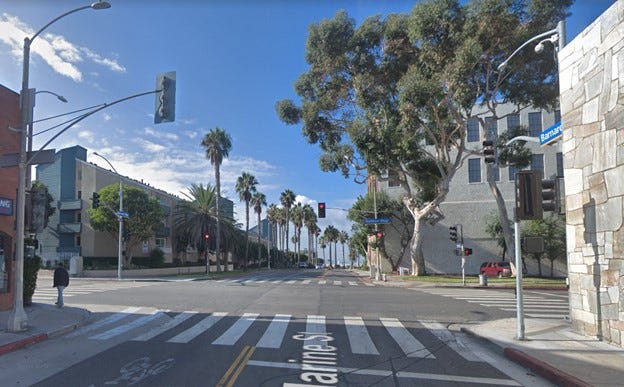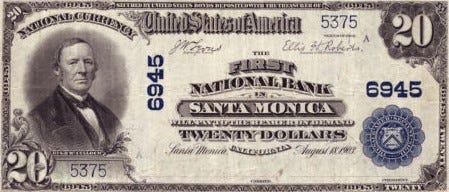True to its name, First National Bank of Ocean Park is the first national bank1 in Ocean Park.2
First National Bank of Ocean Park is incorporated in 1905 with founding stockholders E. J. Vawter, J. M. Elliott, W. D. Longyear, A. R. Fraser, E. J. Vawter, Jr., J. W. Lincoln, and C.H. Mellen. The bank opens for business in a temporary location in the Decatur Block on Navy at Speedway.3
In 1911, work begins on a new 2-story, steel and brick bank building on northwest corner of Marine St and Neilson.4 The lot costs $12,000 and the 41 ft x 80 ft building costs $20,000 to construct. Ye Plantry Building Company, Los Angeles5 is architect and contractor. The street-facing exterior is white glazed brick. The interior is mahogany with marble fixtures and tiled floors.
The bank occupies the entire first floor. In addition to providing the usual retail banking services, First National Bank of Ocean Park also acts as a clearing house for local banks. The Vawter’s Ocean Park Water Company has its offices in the building. Following the 1912 pier fire, the United States Long Distance Telephone & Telegraph Company occupies part of the 2nd floor. Several physicians, including Dr. Charles Goodrich Shipman (1856 - 1918), have offices in the building.
On the adjacent vacant lot, directly west on Marine St., a 4-story office and telephone exchange building is constructed in 1926. Across Marine St. to the south is Fraser’s 1906 Masonic Temple. Directly north on Neilson, is the 1-story Bank of Ocean Park built in 1902.
In 1926, E. J. Vawter, Jr. dies unexpectedly, and is succeeded by R. B. Harris as bank president. In 1927, First National Bank of Ocean Park is acquired by Andrew M. Chaffey’s California Bank.6 California Bank is still there in 1941. In 1943, the Mankind United cult acquires the building for $25,000.7 In 1947, the old bank building is the 18-room Hotel Glass. In 1955, the Sunlight Mission8 occupies the building.
In 1965, as part of the Ocean Park Redevelopment Project, the First National Bank of Ocean Park building (now Sunlight Mission) is demolished - along with everything else west of Neilson between Ocean Park Blvd and the south city border. It’s all gone. Except the Marine Street Telephone Exchange building.
After the Civil War (1861 – 1865), the United States develops a dual banking system. A bank is chartered, examined, and regulated as either a national bank, under the National Bank Act, or as a state chartered bank under any one of fifty different state banking laws.
A national bank charter authorizes a bank to conduct business on a nationwide basis (although branches in other states are not permitted) and subjects the bank to uniform standards and rigorous federal oversight. National banks are chartered by the Office of the Comptroller of the Currency (OCC) pursuant to the authorities granted under the National Bank Act of 1864, and are required to become members of the Federal Reserve System (FRS).
From 1865 through 1929, National banks are able to print National Bank Notes. These notes are backed by U.S. bonds that the individual banks deposited with the United States Treasury. Their design is the same, differing only in the name, location, and charter number of the bank. A National Bank Note is good at any National Bank or the US Treasury - so anyone holding such a note can be sure of getting their money. National Bank Notes are retired as a currency type by the U.S. government in the 1930s - although they are still actively traded amongst collectors.
The First National Bank of Santa Monica is organized in 1888, with directors G. H. Bonebrake, W. S. Vawter and E. J. Vawter, G. S. Van Every, John Steere, Nathan Bundy, and H. C. Baggs. In 1893, Robert F. Jones (1847 – 1939), nephew of Senator John P. Jones(1829 – 1912), acting for John P. Jones and his son Roy Jones (1869-1947), buys the Vawter interests in the bank. As part of the sales contract, the Vawters pledge not to re-engage in the banking business in Santa Monica. The bank is reorganized as a state chartered Bank of Santa Monica with Robert F. Jones as president. In 1922, the Bank of Santa Monica (corner of 3rd St & Santa Monica) is acquired by Andrew M. Chaffey’s California Bank.
The name of Speedway and the 100 block of Marine is changed to Barnard Way in 1966, in honor of City Council member Ben A. Barnard (1904 – 1960).
The Pacific Electric right-of-way is private property and so does not have an official name. To avoid confusion, beginning in 1905, the thoroughfare is called Trolleyway. In 1950, the Pacific Electric ceases operations, and the right-of-way is converted to automobile street use. The name is changed to Neilson Way in 1954, in honor of City Council member George A Neilson (1890 – 1954).
From 1908 to 1911, Arthur S. Barnes’ Ye Planry Building Company of Los Angeles is known for its residential bungalow designs. From 1912 to 1913, the company works on commercial buildings - including the 2‐story First National Bank of Van Nuys (which is acquired by California Bank in 1921) in 1911; the landmarked Junipher Building in Santa Monica in 1912; the 2‐story First National Bank of Ocean Park in 1912; a 1‐story bank building in Canoga Park in 1912; and a 2-story school building in Canoga Park in 1913.
In 1927, California Bank has 46 branches in southern California. Andrew M. Chaffey (1874 – 1941), president of California Bank, is a pioneer of branch banking in California. In 1961, California Bank, Los Angeles merges with First Western Bank and Trust Company, San Francisco to form United California Bank. In 1981, United California Bank changes its name to 1st Interstate Bank, and then is acquired by Wells Fargo in 1996.
Founded by Arthur L. Bell (the “Voice”) in the Great Depression, Mankind United claims that a huge malevolent conspiracy runs the world, and is responsible for war, poverty, and injustice. As a tax dodge, Mankind United re-incorporates as the Church of the Golden Rule. Bell ends up with $3.4 million in assets, including six hotels, five restaurants, Santa Monica's Sorrento Beach Club, Wavecrest Beach Club, and Santa Monica Athletic Club. Government intervention and sedition convictions (overturned on appeal in 1947) of the anti-war leaders, force the Church of the Golden Rule into bankruptcy. In 1945, the barricaded empty California Bank building is seized by force by the State appointed receiver.
Harold Maurice Feldman (1915 - 2003). Born in NY to a Jewish family, Feldman converts to Christianity. With his wife, Willa Mae Russell Feldman (1915 - 2000), Feldman operates the Sunlight Mission providing food, shelter, and clothing to the homeless. The Sunlight Mission starts at 124 Marine in 1950. Feldman acquires the Hotel Glass in 1955. To make way for the Ocean Park Redevelopment Project, the Sunlight Mission moves to 1754 14th St in 1965. Sunlight Mission has a thrift store at 2611 Main St (1958 - 1960) and then at 2701 Main St (1960 to 1975).



